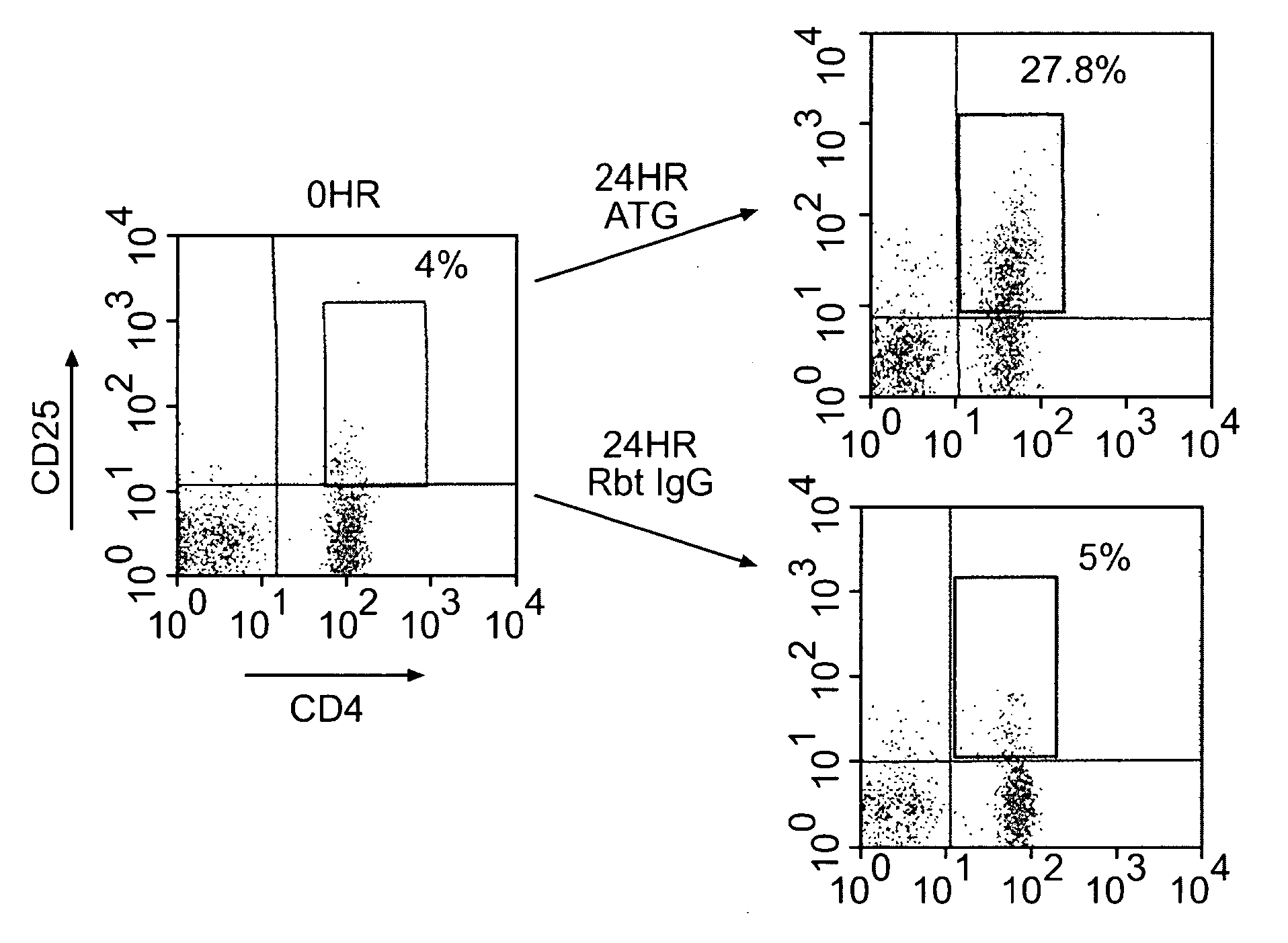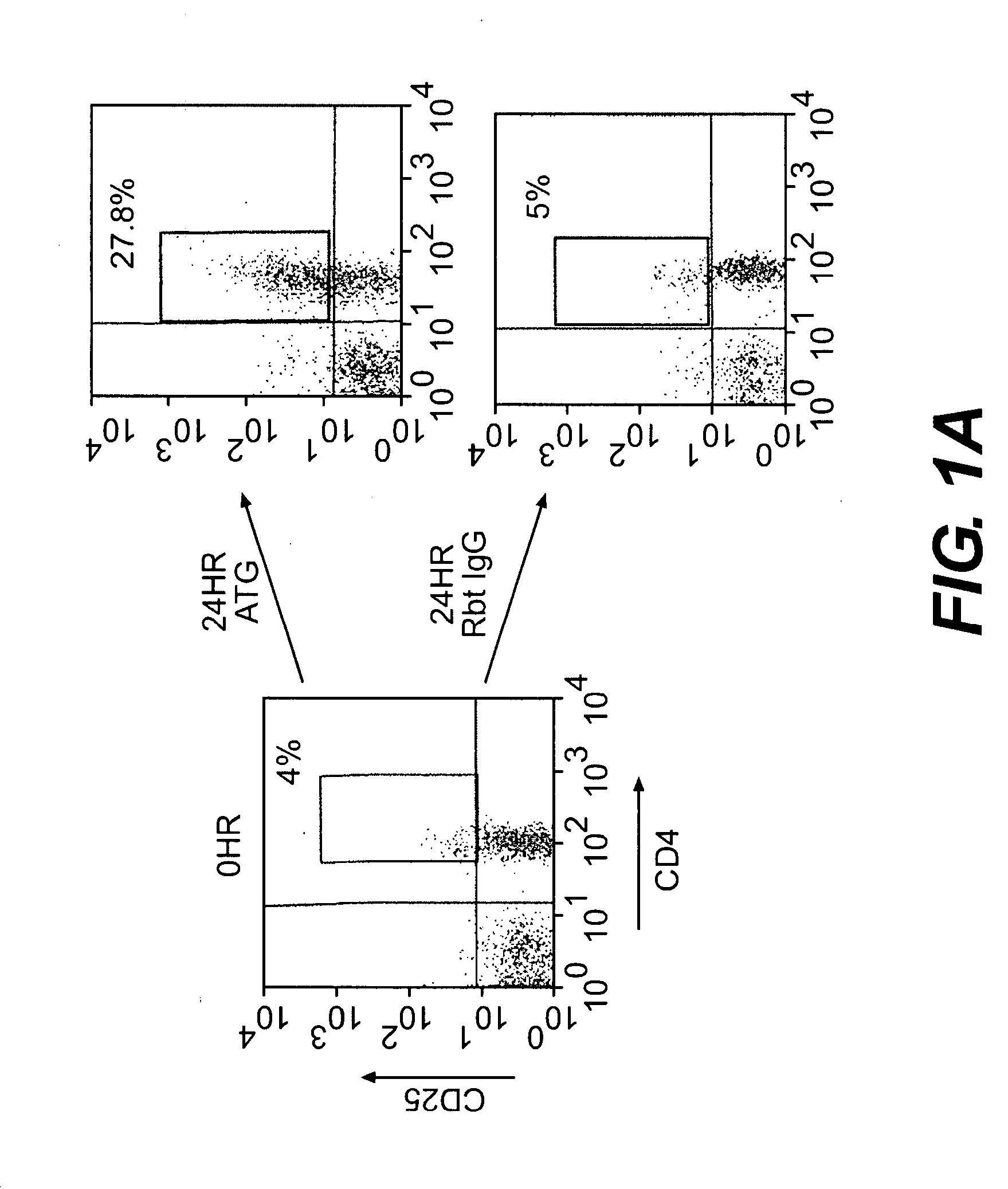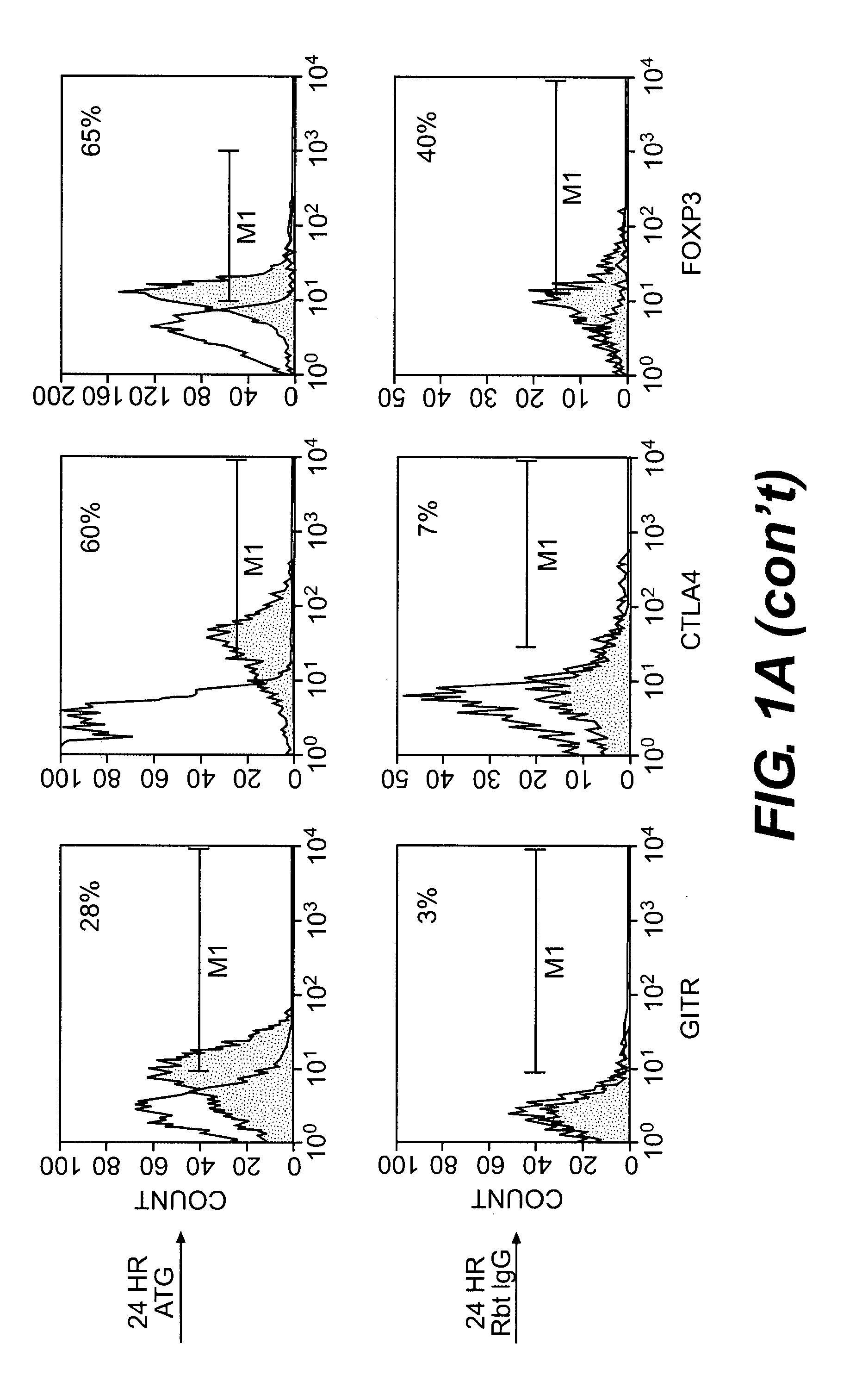Methods of Using Anti-Thymocyte Globulin and Related Agents
a technology of thymocyte globulin and anti-thymocyte globulin, which is applied in the direction of immunosuppressive therapies, antibody medical ingredients, peptide/protein ingredients, etc., can solve the problems of limited immunosuppressive therapies, significant adverse side effects, and difficult long-term transplant survival in a host, so as to suppress aberrant immune responses, promote the generation and promote the expansion of regulatory t cells
- Summary
- Abstract
- Description
- Claims
- Application Information
AI Technical Summary
Benefits of technology
Problems solved by technology
Method used
Image
Examples
example 1
ATG Expands CD4+CD25+ Regulatory T cells
[0103]Blood from ten healthy donors was obtained in heparinized tubes, and peripheral blood mononuclear cells (PBMCs) were isolated by standard Ficoll® density gradient centrifugation. PBMCs were incubated at 37° C., 5% CO2, with 10 μg / ml Thymoglobulin® or rabbit IgG (control) for varying time periods of 0, 6, 18, 24, 48, 72, and 96 hours. These cultures are referred to herein as “generating cultures.”
[0104]Cells were then harvested and analyzed using flow cytometric analysis. 2×105 cells per sample were stained with anti-human CD4-allophycocyanin (APC), CD25-phycoerythrin (PE), glucocorticoid-induced tumor necrosis factor receptor (GITR)-flourescein isothiocyanate (FITC), and CD8-APC (BD Bioscience, San Jose, Calif.; eBioscience, San Diego, Calif.). For the intracellular CTLA-4 staining, cells were permeabilized with Perm buffer (BD Biosciences, San Jose, Calif.) for 20 minutes at 4° C. and labeled with anti-CTLA-4 for 30 minutes at 4° C. For...
example 2
ATG Generates CD4+CD25+FOXP3+ Regulatory T Cells
[0109]Human PBMCs were placed into culture for 5-7 days in AIM V media containing non-heat inactivated 10% human AB serum. Cultures were supplemented with Thymoglobulin® at 100 μg / ml or rabbit Ig (control). Expression of cell surface receptors was determined by flow cytometry. Cells were washed in PBS and resuspended in PBS supplemented with 1% human AB serum. Fluorescently labeled anti-CD4 and anti-CD25 antibodies were added to the cells and incubated for 30 minutes at 4° C. in the dark. Cells were washed then incubated in Fix / Perm buffer (eBioscience) at 4° C. for 30 minutes. Cells were then washed and stained for 30 minutes with anti-human FOXP3 antibody (eBioscience). Cells were washed, resuspended in PBS and analyzed on a FacsCalibur cytometer (BD Biosciences). FIG. 2 illustrates that in comparison to rabbit IgG control, a four day treatment with Thymoglobulin® of PBMCs generated a significant population of CD4+CD25+ cells, more t...
example 3
ATG Expands Regulatory T Cells in a Dose-Dependent Manner
[0110]PBMCs were isolated and incubated for 24 hours with 1, 5, 10, 50 and 100 μg / ml ATG or a rabbit IgG as per Example 1. Cells were then harvested and analyzed by flow cytometry.
[0111]As shown in Table 5, a dose-dependent increase in percentage of CD4+CD25+ T cells was observed in between 1 and 10 μg / ml of ATG. At higher concentrations, no appreciable further increase was observed. Increased activation of CD4+ T cells was also observed as indicated by the percentage of CD4+CD69+ cells (see Table 5). FOXP3 expression in CD4+CD25+ T cells remained substantially the same with increasing the dose of ATG (13±4.2% at 50 μg / ml to 15.2±0.35% at 100 μg / ml).
TABLE 5ATG% CD4+CD25+% CD4+CD69+(μg / ml)T cells*T cells**16.3 ± 0.5 4.4 ± 4.8 512 ± 4.915.6 ± 7.7 1020 ± 6.512 ± 7.25021.7 ± 5 21 ± 5.610021 ± 6.722 ± 5 *Rabbit IgG controls were 3-5%;**Rabbit IgG controls were less than 1%.
PUM
| Property | Measurement | Unit |
|---|---|---|
| concentration | aaaaa | aaaaa |
| concentration | aaaaa | aaaaa |
| concentration | aaaaa | aaaaa |
Abstract
Description
Claims
Application Information
 Login to View More
Login to View More - R&D
- Intellectual Property
- Life Sciences
- Materials
- Tech Scout
- Unparalleled Data Quality
- Higher Quality Content
- 60% Fewer Hallucinations
Browse by: Latest US Patents, China's latest patents, Technical Efficacy Thesaurus, Application Domain, Technology Topic, Popular Technical Reports.
© 2025 PatSnap. All rights reserved.Legal|Privacy policy|Modern Slavery Act Transparency Statement|Sitemap|About US| Contact US: help@patsnap.com



